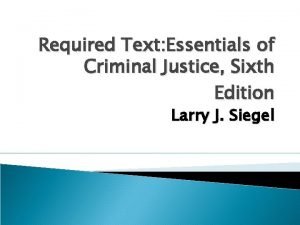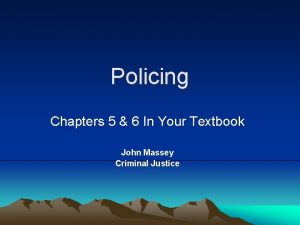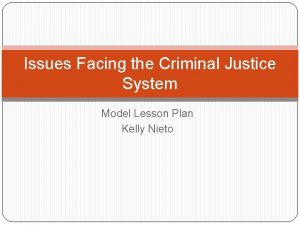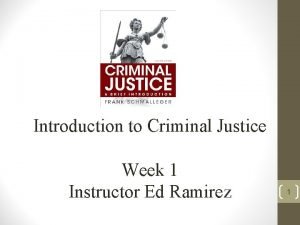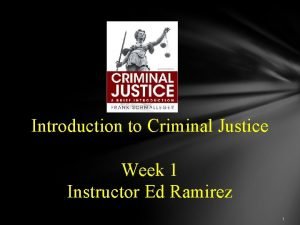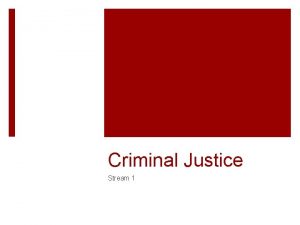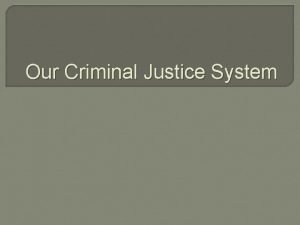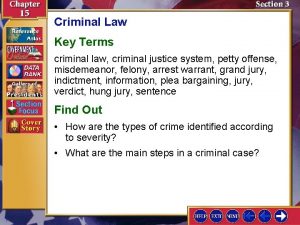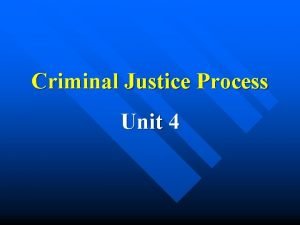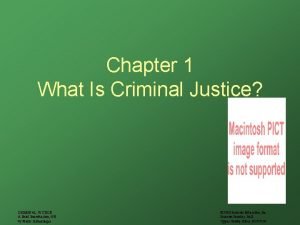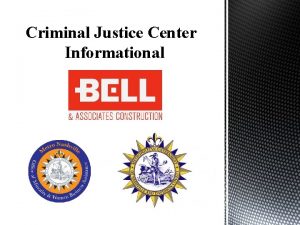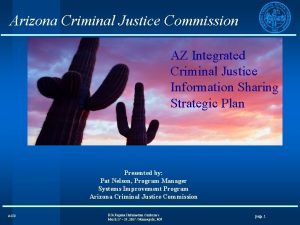Criminal justice social inequalities and social justice in











- Slides: 11

Criminal justice, social inequalities and social justice in Scotland. Paper for Seminar at The Open University in Scotland, 10 February 2011 Hazel Croall (Professor Emerita, Glasgow Caledonian University).

Focus on Scotland: The potential of a ‘tartan’ lens? n The neglect of Scotland (and other jurisdictions) in ‘Anglocentric’ criminology for example: The ‘British’ Crime Survey; difficulties of meaningful comparisons. Criminology Texts n Theoretical discussions/ analysis: for example q q n discussions of juvenile gangs (from ‘no gangs in Britain’ to focus on England ) race, ethnicity and crime (neglects different Scottish context). Extends beyond crime to other relevant areas: for example, poverty, employment, deprivation, race and ethnicity.

Focus on Scotland: The potential of a ‘tartan’ lens? n n Why important? Misleading for students; Affects discussions on criminal justice Neglects opportunities for comparative analysis

Relationships between Crime and Inequalities: crime deprivation n Focus (of book) on interrelationships between crime and social inequalities of class, race, ethnicity, gender, age and others. n Popular association between crime and social and economic deprivation; dangerous people/ dangerous places (Law et al 2010). n Scottish popular culture for example, films (Trainspotting, NEDS); novels – Tartan Noir; autobiographies; ‘true crime’; journalism. n Politics: the ‘underclass’; ‘Shettleston man’.

Relationships between Crime and Inequalities n n n Reflected in research: relationships between imprisonment and social exclusion (Houchin 2005); high levels of victimisation, repeat victimisation and fears of crime among ‘most deprived’ (Mooney et al 2010); Links between serious and persistent youth offending with indices of deprivation. But note gaps: information often quantitative, contrasts ‘most’ and ‘least’ deprived; ‘risk factors’ (being male; low income); Know little about interrelationships between socio economic and other inequalities as they relate to crime and victimisation –limited information about, for example, race and ethnicity (Croall and Frondigoun 2010).

Relationships between Crime and Inequalities n n Need more qualitative research –focus on ‘lived realities’ Need to recognise relationship between crime and Widening gaps between rich and poor culture -Young (2007) ‘cultural inclusion’ coupled with ‘structural exclusion’. n Particularly relevant in Scotland: Mooney and Wright (2009) suggest greater levels of polarisation. n Need to recognise the role of criminal justice: To what extent are ‘usual suspects’ (Mc. Ara and Mc. Vie 2005; 2010) more likely to be targeted? An emergent ‘parallel’ justice system (Munro and Mc. Neill 2010)?

Crimes of the less deprived and corporations n n Crimes of ‘greed’ as opposed to ‘need’ Include: ‘Everyday crimes’ of middle classes (tax evasion; insurance fraud) Professional frauds (doctors, accountants, lawyers etc. - generally dealt with by private justice) Bankers and serious financial frauds Environmental crimes: wildlife crime; ‘black’ fish. Corporate crime (Safety crimes; consumer crime; environmental crime).

Crimes of the less deprived and corporations Scottish Examples (Ross and Croall 2010; Walters 2010) Transco; Piper Alpha; Stockline; Weir’s (£ 14 million penalty for sanctions busting); Nuclear and Defence Industries n n Different form of criminalisation and regulation Illustrates relationships between criminal and social justice.

Prospects for criminal justice: need to focus on: n n n More ‘qualitative’ research (to provide a better ‘evidence base’ for policy) More attention to the comparative dimension within and beyond UK – other small jurisdictions Tackling wider inequalities A fairer criminal justice system Resisting popular punitivism

Prospects for criminal justice: some Positive indicators n n Consistent indications of falling rates of many kinds of crime (youth disorder, property crime, homicide, violent crime, knife crime) Increase in research (SIPR; SCCJR) Some willingness to consider heavier punishments/ more prosecution of corporations Some move away from overly punitive policies (presumption against short prison sentences; community options; initiatives with young people)

Prospects for criminal justice: Threats n n Economic recession and resource constraints Will some forms of crime increase? Reduction in resources for voluntary and public sector (impact on, for example, community payback; policing; regulation of environmental and safety crimes and also research). Persistence of popular punitivism: for example, resistance to shorter prison sentences by main opposition parties; tenor of debates about criminal justice policy.
 Criminal justice and public policy guelph
Criminal justice and public policy guelph Criminal justice and corrections
Criminal justice and corrections Unit 2 criminal law and juvenile justice
Unit 2 criminal law and juvenile justice Criminal justice in america 8th edition
Criminal justice in america 8th edition Division of criminal justice ct
Division of criminal justice ct The criminal justice funnel
The criminal justice funnel Grass eater vs meat eater police
Grass eater vs meat eater police Eighth amendment excessive bail
Eighth amendment excessive bail Consensus model criminal justice
Consensus model criminal justice Consensus model criminal justice
Consensus model criminal justice Criminal justice stream
Criminal justice stream Consensus model criminal justice
Consensus model criminal justice





